check engine AUDI S7 2013 Owner's Guide
[x] Cancel search | Manufacturer: AUDI, Model Year: 2013, Model line: S7, Model: AUDI S7 2013Pages: 310, PDF Size: 77.45 MB
Page 246 of 310
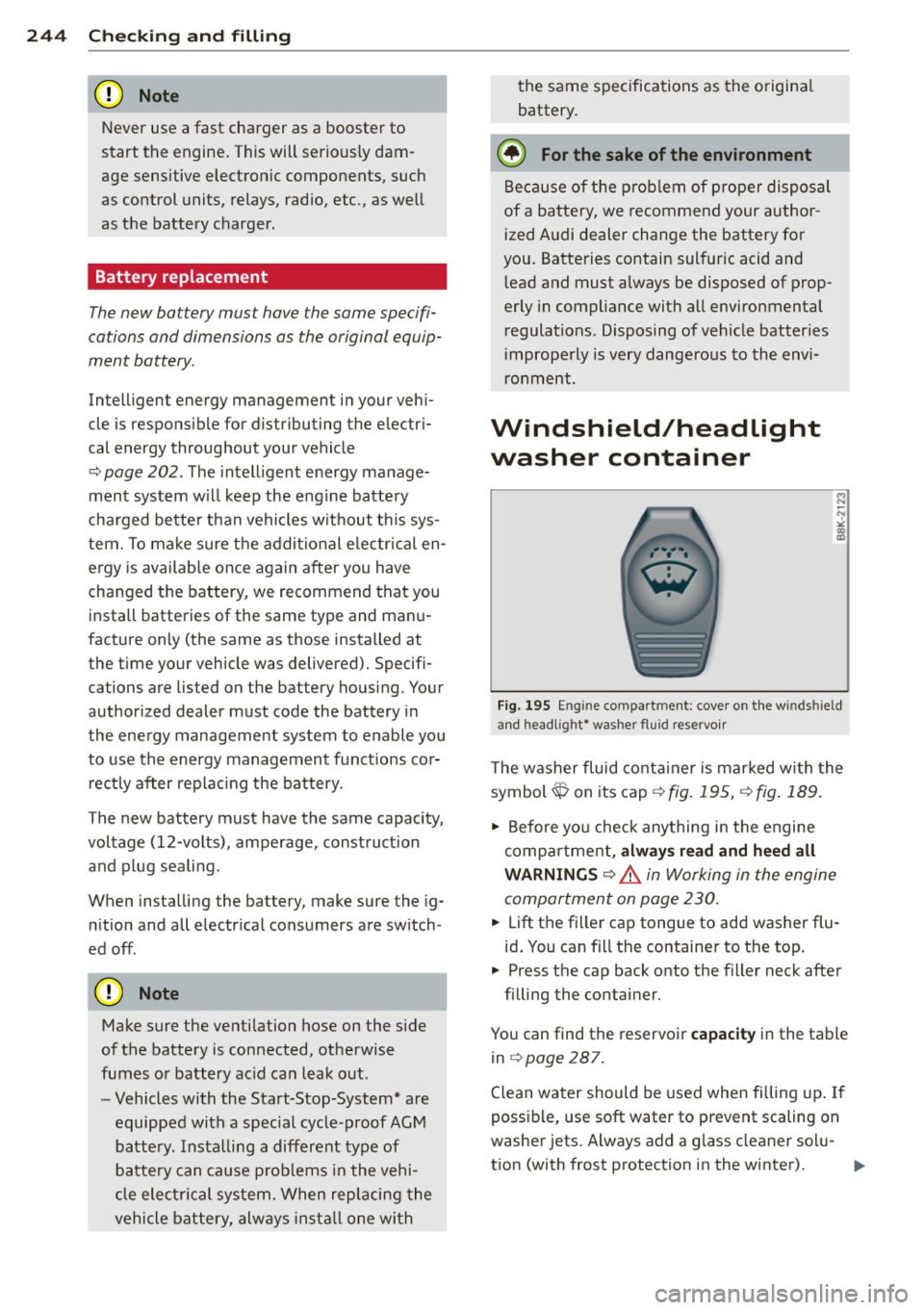
24 4 Ch eck ing and filling
Never use a fast charger as a booster to
start the engine. This will seriously dam
age sensitive electronic components, such
as control units, relays, rad io, etc., as well
as the battery charger.
Battery replacement
The new battery must have the same specifi
cations and dimensions as the original equip
ment battery .
Intelligent energy management in your veh i
cle is respons ible for d istributing the electr i
cal energy throughout your vehicle
c::> page 202. The intell igent energy manage
ment system w ill keep the engine battery
cha rged bette r than vehicles w ithout t his sys
tem. To make sure the additional e lectrica l en
e rgy is availab le once again after you have
changed the battery, we recommend that you
install batteries of the same type and man u
facture only (the same as those installed at
the time your vehicle was delivered). Specifi
cations are listed on the battery hous ing. Your
author ized dealer must code the battery in
the energy management system to enable you
to use the energy management funct ions cor
rectly after replac ing the battery .
The new battery must have the same capacity ,
voltage (12-volts), amperage, const ruct ion
and p lug sealing.
When insta lling the battery, make sure the ig
n ition and all e lectr ica l consumers are sw itch
ed off .
{[) Note
Make sure the venti lation hose on the s ide
of the battery is connected, ot herwise
fumes or battery ac id can leak out.
- Vehicles with the Start-Stop-System* are
equipped with a special cycle-proof AGM
batte ry. Insta lling a differe nt type of
batte ry can ca use p rob lems in the vehi
cle elect rical system. When rep lacing the
vehicle bat tery, always ins ta ll one wi th the same specifica
tions as the o rigina l
battery .
~ For the sake of the env ironment
B ec ause o f th e p rob lem of p roper disposal
of a battery, we recommend your author
ized Audi dealer change the battery fo r
you. Batteries contain sul fur ic acid and
l ead and must always be disposed of prop
erly in compl iance with all environmental
regulations. Disposing of veh icle batter ies
i mproperly is very dange rous to the envi
r onment.
Windshield/headlight
washer container
Fi g. 195 Eng in e compa rt m ent: cove r on t he w inds hield
and head lig ht* was her flu id reservo ir
T he washer fluid co nta iner is mar ked w ith the
symbol$ on its cap
c::> fig. 195, c::> fig. 189.
.,. Before yo u check anything in the engine
compa rtment,
alwa ys read and heed all
WARNINGS
c::> A in Working in the engine
compartment on page 230 .
.. Lift the fi ller cap tongue to add washer flu
id . You can fi ll the containe r to the top .
.. Press the cap back onto the filler neck after
filling the container .
You can find the reservoi r
capacity in the table
in
c::> page 287.
C lean water should be used when filling up . If
possible, use soft water to prevent scaling on
washe r jets. Always add a g lass cleaner so lu
t ion (with frost protection in the winter).
Page 247 of 310
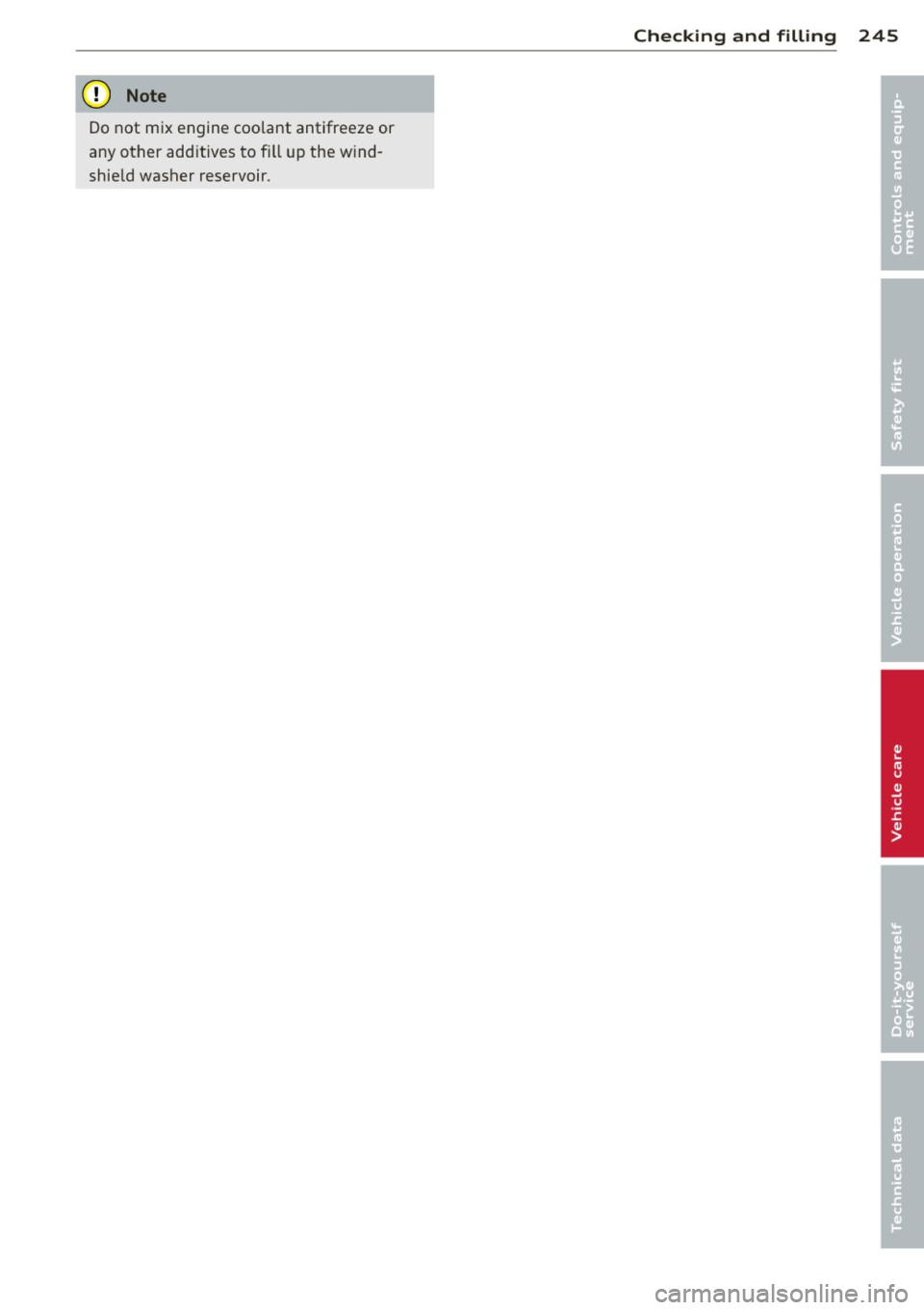
(D Note
Do not mix engine coolant antifreeze or
any other add itives to fi ll u p the w ind
shie ld washer reservoir.
Checkin g and fillin g 245
•
•
Page 283 of 310
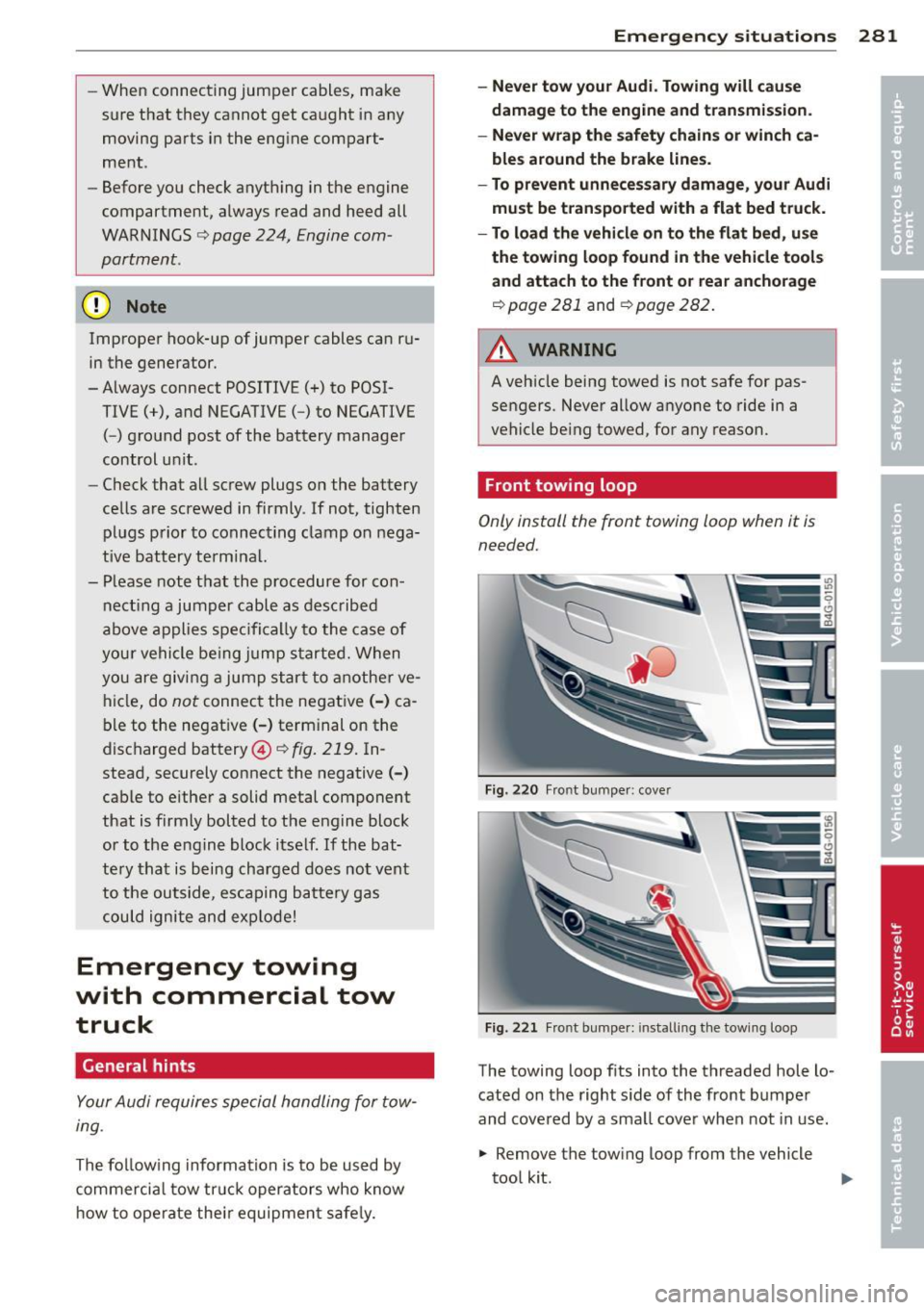
-When connecting jumper cables, make
sure that they cannot get caught in any
moving parts in the eng ine compart
ment .
- Before you check anything in the engine
compartment, always read and heed all
WARNINGS ¢
page 224, Engine com
partment.
(D Note
Improper hook-up of jumper cables can r u
in the generator.
- Always connect POSITIVE(+) to POSI
TIVE(+), and NEGA TIVE( -) to NEGATIVE
( - ) ground post of the battery manager
control u nit .
- Check that all sc rew plugs on the battery
cells are screwed in firmly. If not, tighten
pl ugs p rior to connecting clamp on nega
tive batt ery terminal.
- P lease note that the procedure for con
nect ing a jump er cable as describe d
above applies spec ifically to the case of
your vehi cle be ing j ump s tarted. When
you are giving a jump star t to anothe r ve
hicle, do
not connec t the negative( -) ca
b le to the negat ive (-) term inal on the
discharged battery@¢
fig. 219. In
stead, securely connect the negative(-)
cable to e ither a solid metal component
that is firmly bolted to the engine block
or to the engine block itself.
If the bat
te ry tha t is being charged does not vent
to the ou tside, es ca ping b attery gas
could ignite and ex plode!
Emergency towing
with commercial tow
truck
General hints
Your Audi requires special handling for tow
ing .
The fo llow ing informa tion is to be used by
commercia l tow tr uck operators who know
how to ope rate thei r equipmen t sa fe ly.
Emergenc y situ ation s 281
-Ne ver tow your Audi. Towing will cau se
damage to the engine and tran smission.
- Never wrap the safety chain s or w inch ca
ble s around the brake lines.
- To prevent unnece ssary damage , your Audi
must be transported with a flat bed tru ck.
- To load the vehicle on to the fl at bed , use
the towing loop found in the vehicle tools
a nd attach to the front or rear anchora ge
¢page 281 and ¢page 282 .
_& WARNING
A vehicle being towed is not safe for pas
sengers. Never allow anyo ne to ride in a
vehicle be ing towed, for any reason.
Front towing loop
Only install the front towing loop when it is
needed.
Fig. 22 0 Front bumpe r: cove r
Fig. 22 1 Front bu mpe r: in stall ing t he tow ing loop
-
The towing loop fits into the threaded hole lo
cated on the right s ide of the front bumpe r
and cove red by a sma ll cover when not in use.
.. Remove the tow ing loop from the vehicle
too l kit .
Page 286 of 310
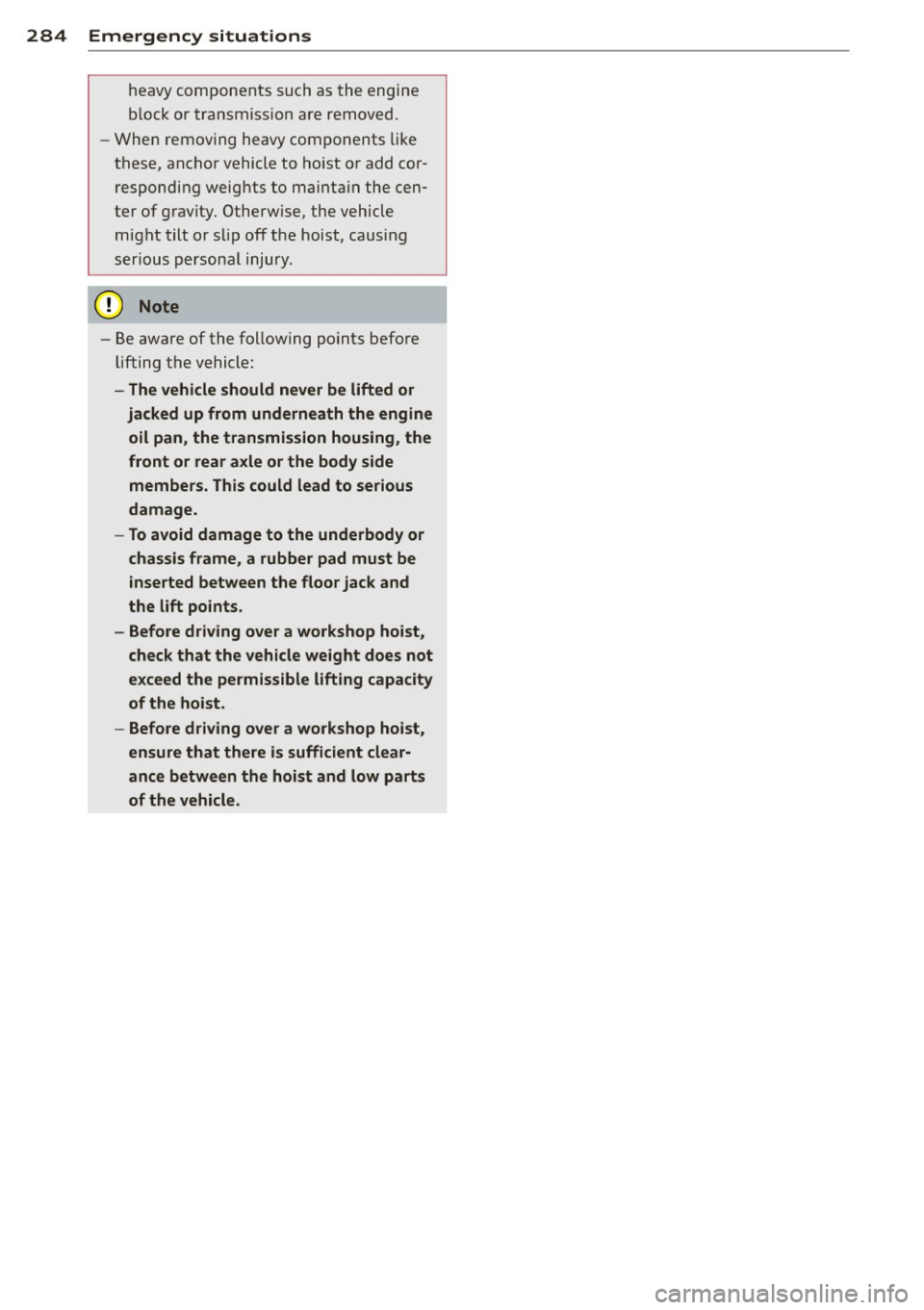
284 Emergency situations
heavy components such as the engine
b lock or transmiss io n are removed.
- W he n removing heavy components like
these, ancho r vehicle to ho ist o r add cor
responding weig hts to ma inta in the cen
ter of g ravity . Othe rwise, the vehicle
might tilt or s lip off t he hoist, causing
ser ious p erson al injury.
(D Note
-Be awa re of the follow ing points befo re
li fting the vehicle:
- The vehicle should never be lifted or
jacked up from underneath the engine oil pan, the transmission housing, the
front or rear axle or the body side
membe rs. This could lead to ser ious
damage.
- To avoid damage to the underbody or
chassis frame , a rubber pad must be
i nserted between the floor jack and
the l ift points.
- Before driving over a workshop hoist,
check that the veh icle weight does not
exceed the permissible lifting capacity
of the hoist .
- Before driving over a workshop hoist,
ensure that there is sufficient clear
ance between the hoist and low parts
of the vehicle.
Page 292 of 310
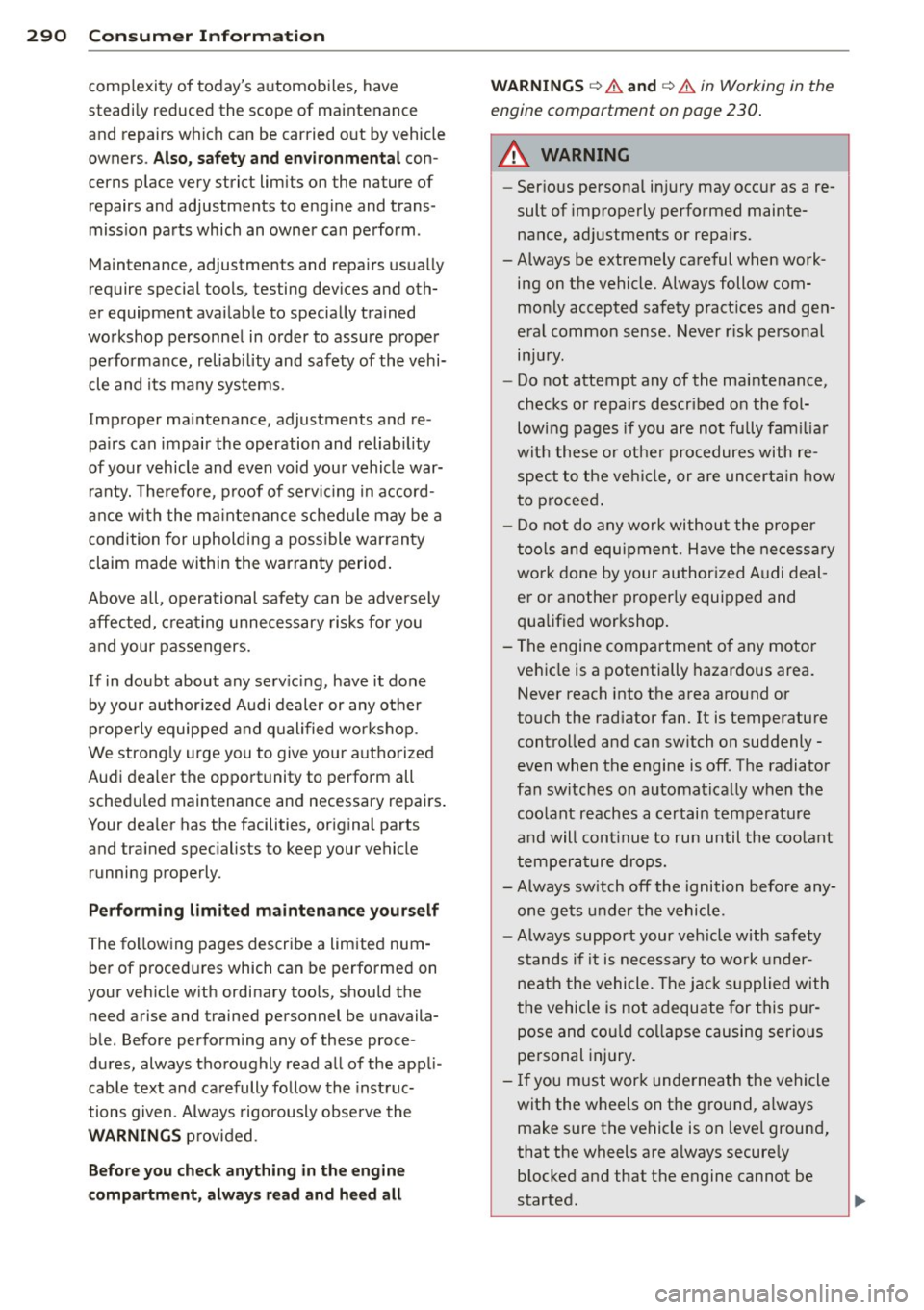
29 0 Con sum er Inf ormation
comp lexity of today's automobi les, have
steadi ly reduced the scope of maintenance
and repairs which can be carried out by vehicle
owners.
Also, s afety an d e nvir onm ent al con
cerns place very strict limits on the nature of repairs and adjustments to engine and trans
miss ion pa rts which an owner can perform .
Maintenance, adjustments and repa irs usua lly
require special tools, testing devices and oth
er equipment avai lab le to specially trained
workshop personnel in order to assure proper
performance, reliab ility and safety of the vehi
cle and its many systems .
Improper ma intenance, adjustments and re
pa irs can impair the operation and reliab ility
of your vehicle and even void your vehicle war ranty. Therefo re , proof of servici ng in accord
ance w it h the ma intenance sched ule may be a
condition for upholding a poss ible warranty
claim made within the warran ty period.
Above all, operational safety can be adve rsely
affected, creating unnecessary risks for you
and your passengers.
If in doubt about any serv icing, have it done
by your author ized Audi dealer or any other
p roperly equipped and qualified workshop .
We strong ly urge you to give your authorized
Audi dealer the opportunity to perform all
schedu led maintenance and necessary repairs .
Your dea ler has the facilities, or iginal parts
and tra ined spec ialists to keep your vehicle
running properly .
Performing lim it e d m aint en anc e y ourself
The fo llowing pages describe a limited num
ber of procedures which can be performed on
you r vehicle with ordinary too ls, shou ld the
need arise and trained personnel be unavaila
ble. Before performing any of these proce
dures, always thoroughly read all of the app li
cable text and ca refully follow the instruc
tions given. Always rigorously obse rve the
WARNINGS p rovided .
Before you ch eck anything in th e engin e
compartme nt, alway s read an d heed all WARNINGS
¢ & a
nd ¢ & in Working in the
engine comportment on page 230 .
A WARNING
--Serious personal in jury may occur as a re-
sult of improperly performed mainte nance, adjustments or repa irs.
- Always be extremely careful when work
ing on the vehicle. Always follow com
monly accepted safety pract ices and gen
eral common sense. Never r isk personal
in jur y.
- Do not attempt any of the maintenance,
checks or repairs descr ibed on the fol
lowing pages if you are not fu lly fam iliar
with these or other procedures with re spect to the vehi cle, or are uncerta in how
to proceed .
- Do not do any work withou t the proper
too ls and equipment . Have the necessary
work done by your authorized A udi deal
er or anothe r properly equipped and
qualified workshop.
- The engine compar tment o f any motor
vehicle is a potentially hazardous area. Never reach into the area around or
touch the rad iator fan. It is temperature
control led and can sw itch on suddenly -
even when the engine is off . The radiator
fan switches on automatically when the
coo lant reaches a certain temperature
and will cont inue to run until the coo lant
tempera ture drops.
- Always sw itch off the ignition before any
one gets under the vehicle.
- Always support your veh icle with safety
s tands if it is necessary to work under
neath the vehicle. The j ack s upp lied with
the vehicle is not adequate for this pur
pose and cou ld co llapse causing serio us
pe rsonal injury .
- If you must work underneath the vehicle
with the wheels on the ground, a lways
make sure the vehicle is on leve l ground,
that the wheels are a lways secure ly
blocked and that the engine cannot be
started .
Page 293 of 310
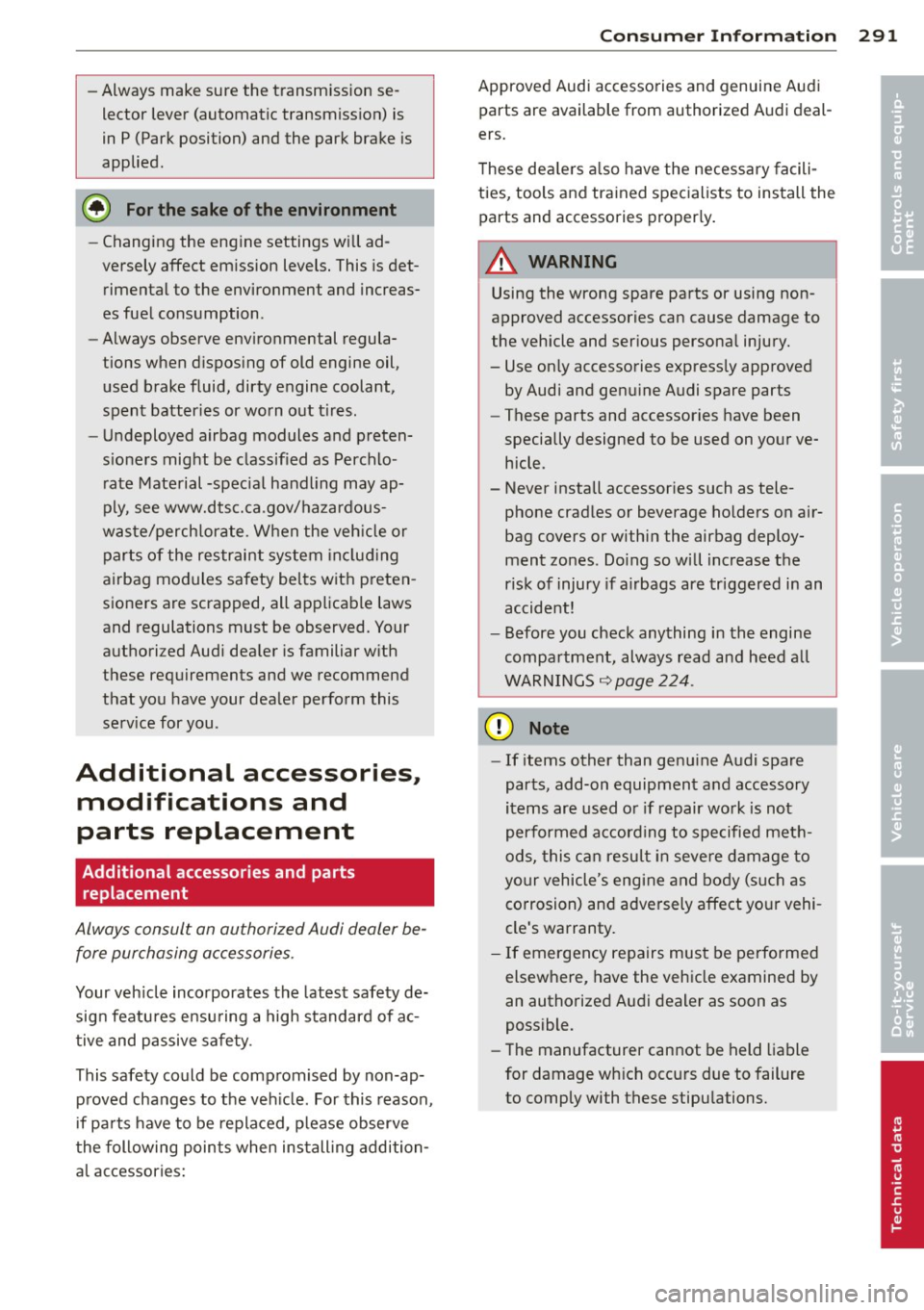
-Always make sure the transm ission se
lector lever (automatic transmiss io n) is
in P (Park position) and the park bra ke is
applied.
@) For the sake of the environment
- Changing t he eng ine settings w ill ad
versely affect em ission levels. This is det
rimental to the environment and increas
es fuel consumption .
- Always observe env ironmental regula
tions when d isposing of old engine oil,
used brake fluid, dirty engine coolant,
spent batter ies or worn out t ires.
- Undeployed airbag modules and preten
s ioners might be classified as Perchlo
r ate Mate rial -spec ia l hand ling may ap
ply, see www.dts c.ca .gov/haza rdous
was te/perch lorate. When the veh icle or
parts of the res traint system in cl ud ing
a irbag modules safety be lts wit h preten
sioners are scrapped, all applicable laws
and regulations must be observed. Your
a uthorized Audi dea ler is familiar w ith
these requirements and we recommend
that you have your dea ler perform this
se rv ice for you .
Additional accessories,
modifications and
parts replacement
Additional accessories and parts
replacement
Always consult an authorized Audi dealer be
fore purchasing acce ssories.
Your veh icle inco rporates the latest safety de
sig n featu res e nsu ring a high standard of ac
tive and passive safe ty .
This safety could be comp romised by non-ap
p roved changes to the ve hicle. For this reason ,
if pa rts have to be replaced, please observe
t he following points when ins tall ing addition
a l accessories:
Con sumer In formation 29 1
Approved Audi accesso ries and genuine Aud i
parts are available from authorized A udi deal
ers.
T hese de alers a lso have the necessary facili
ties, tools and tra ined spec ialists to install the
parts and accessories proper ly .
A WARNING
Using the wrong spare pa rts or using non
approved accessories can cause damage to
the vehicle and ser ious persona l injury.
- Use on ly accessories express ly approved
by Audi and ge nuine Audi spare parts
- These parts and accessories have been
specially designed to be used on yo ur ve
hicle.
- Never install accessor ies such as tele
phone crad les or beverage ho lders o n air
bag covers or withi n the airbag deploy
ment zones . Do ing so will increase t he
ris k of injury if a irbags are triggered in an
accide nt!
- Before you check anything in the engine
compa rtment, always r ead and heed a ll
W ARNINGS ~
page 224.
(D Note
-If items other than genu ine A udi spare
par ts, add-on equipmen t and accessory
items are used o r if repair wo rk is not
performed a ccord ing to spe cified met h
ods, this ca n resu lt in s evere damage to
yo ur vehicle's engine and body (s uch as
co rrosion) and adversely affect yo ur vehi
cle's warranty .
- If emergency repairs mus t be performed
elsewhere, have the veh icle examined by
an authorized Aud i dealer as soon as
possible.
- The manufacturer cannot be held liable
for damage wh ich occ urs due to failure
to comply with these stipu lations.
•
•
Page 297 of 310

Index 295 ____________________________ ...:.:..:.=.:::.::.:
Automatic climate control
Air vents ... ................ ... .... 72
Automatic recirculation . . . . . . . . . . . . . . 73
Operation ................... .. ....
71
Setup ... ..................... .... 73
synchronizing . ........ ... ... ... ... . 72
Automatic Shift Lock (ASL) ... ... .. .. .
110
A t t· t . .
u oma 1c ransm1ss1on ....... .. .. .. . 109
Automatic Shift Lock (ASL) . .. .. .. .. . 110
Driving .. .. ............. .. .. .. .. . 111
Emergency mode ............ ... .. . 114
Emergency release . . . . . . . . . . . . . . . . . 115
Kick-down . ................. ... ... 113
Manual shift program ..... .. .. .. .. . 113
Selector lever . . . . . . . . . . . . . . . . . . . . . 109
Automatic wipers ................ .... 47
Auto Safety Hotline ......... ... ... ..
138
Average consumption ....... .. .. .. .. .. 25
Average speed . . . . . . . . . . . . . . . . . . . . . . . 25
Avoid damaging the vehicle ...... ... .. 205
B
Bag hooks . . . . . . . . . . . . . . . . . . . . . . . . . . 65
Brake system
Anti-lock braking system .............
20
Brake assist system ................ 196
Brake booster .. .. ................. 200
Brake fluid .. .. .. .... ............. 239
Brake fluid specifications for refill and re
placement . . . . . . . . . . . . . . . . . . . . . . .
240
Brake light defective . . . . . . . . . . . . . . . . 22
Brake pads .... .. .. . ..............
204
Electromechanical parking brake ... .. . 78
Fluid reservoir ... .. ...............
239
How does moisture or road salt affect the
brakes? ....... .... ...............
199
Warning/indicator lights ........ .... . 15
Worn brake pads symbol ............ . 21
braking guard
Settings ... ... .... ................
93
Braking guard ..... .. ................ 86
Messages . .. .. .. .... ........... .. . 93
Break-in period .. .. .. ............... 204
Brake pads .. .. .. .... ... .... .... .. 204
Tires
Bulbs
....... ..... .. ...............
204
278
Battery . . . . . . . . . . . . . . . . . . . . . . . . . . .
240 C
Charging ... ................ ... ... 243
Important warnings ......... ... .. . 241
Jump starting ..................... 279
Location . .. ............. .... .. ...
241
low . .. ... . .... ............. .. .. . 202
Replacing the battery . . . . . . . . . . . . . . 244
State of charge .............. .... .. 202
Winter operation ............ .... .. 240
Working on the battery .... .. .. .. .. . 241
Before driving .. ........... .. .. .. ... 130
Blended gasoline ................... 225
Blower (automatic climate control) . . . . . . 72
Blower (climate control) . . . . . . . . . . . . . . .
69
Body cavity sealing ......... .. .. .. .. . 219
Booster seats ..... .. ...... .. .. .. .. . 184
Brake fluid
Changing the brake fluid ........... .
240
Checking the brake fluid level . .. .. .. . 239
What is the correct brake fluid level? .. 239
What should I do if the brake fluid warn-
ing light comes on? .......... .. ....
239
California Proposition 65 Warning ..... 231
Battery specific . . . . . . . . . . . . . . . . . . . 242
Capacities . . . . . . . . . . . . . . . . . . . . . . . . . 287
Engine oil ... .. .. .................
232
Car care .... .. .. .. ................. 213
Exterior ......... .. ..... .......... 213
Interior ... .. .. .. .. . .. .... ........ 219
Car carrier
Transporting your vehicle ....... .. .. 283
Cargo area ... ..... .. ...............
136
Cargo net . . . . . . . . . . . . . . . . . . . . . . . . . . . 65
Catalytic converter ... .............. . 205
Center armrest
Cockpit ... .. .. .. ................. .
54
Central locking .. .... ... ....... ...... 34
Emergency locking .. ... ....... .... .. 38
Certification .. .. .. .................
292
Changi ng a wheel .. .... ......... .... 269
Changing engine oil .. ... ....... .... .
236
Chassis (undercoating) . . . . . . . . . . . . . . . 219
•
•
Page 298 of 310

296 Index
Checking Engine coolant level ................ 237
Tire pressure . ............. ... .... . 252
Ch ild restra ints
Danger of using child restra ints in the
front seat . ................. ..... . 151
Where can I get additional information
about child restraints and their use? .. 193
Child restraint system anchors ... .... . 189
Child safety .. .. . .......... .. .. .... . 175
Convertible locking retractor .. .. .. .. . 186
Important safety instructions for using
chi ld safety seats ......... .. .. .... . 179
I mportant things to know when dr iving
with chi ldren . ............... .... . 175
Tether anchors ............ ... .... . 192
Tether straps ..................... 192
Child safety lock Rear doors .............. .. .. .... .. 40
Child safety seats .......... .... .... . 181
Booster seats . .......... ... .. .. ... 184
Convertible ch ild seats .... .. .. .. .. . 182
Convertible locking retractor .. .. .. ... 186
H ow do I proper ly install a child safety
seat in my vehicle? ...... .. .. .. .. .. . 179
I nfant seats .............. ... .... . 181
I nstalling . ............... ... .... . 186
Installing a child restraint using the
LATCH system ................ .... . 191
LATCH system ............ .... ..... 191
Lower anchorages ............ ..... 190
Mounting and releasing the anchorage
hook .. .. .. ... .... ...... ... ... .. . 191
Safety instructions . . . . . . . . . . . . . . . . . 179
Unused safety belts on the rear seat .. 181
Cigarette lighter . . . . . . . . . . . . . . . . . . . . . 58
C leaning
Head-up Display .............. .... . 220
Matte finish paint ............ .... . 215
C leaning and protection ..... .. .. .. .. . 213
A lcantara (synthet ic suede) .......... 223
Engine compartment ....... .... ... . 224
Exhaust tail pipes .......... ... .... . 219
Fabrics and fabric coverings .. .. ..... 220
Instrument panel ............. ..... 221
Interior . . . . . . . . . . . . . . . . . . . . . . . . . . 219
Leather .. .. ... .... ...... ... ... .. . 222
MMI display/controls .. ... ... .. .. ... 219 Plastic
and vinyl . . . . . . . . . . . . . . . . . . . 217
Plastic parts . . . . . . . . . . . . . . . . . . . . . . 221
Safety be lts ... .. ................ . 223
trim strips ................... .... 217
Trim strips ................... .... 217
Cleaning the Head-up Display ......... 220
Climate control Air vents .. .. .. .. ............. .. .. . 70
Climate controls . .. ............. .. .. . 68
Climate control (four-zone)
Operation ..... .. .. .............. .. 71
Climate control (three-zone) Operation . . . . . . . . . . . . . . . . . . . . . . . . . 69
Clock ...... .... .................... 27
Closing Rear lid . . . . . . . . . . . . . . . . . . . . . . . . . . . 38
Sliding/ti lting sunroof ............ .. . 42
Co ld tire inflation pressure .......... .. 250
Coming home . .. .. ............. .... . 45
Compact spare tire .............. .... 268
Compartments . . . . . . . . . . . . . . . . . . . . . . 59
Compliance . .. .. .. ............. .... 292
Consumer Information . . . . . . . . . . 138, 289
Consumption (fuel) ... ........... ... . 25
Contacting NHTSA ................. . 138
Convenience key . . . . . . . . . . . . . . . . . . . . . 36
Starting the engine ............ .... . 75
Stopping the engine (START ENG INE
STOP button) . . . . . . . . . . . . . . . . . . . . . . 77
Switching the ignition on ....... .. .. . 75
Unlocking and locking vehicle .. .. .. .. . 36
Convertib le child safety seats ... .... .. 182
Convertible locking retractor Activating ..... .. .. ........ ... .. .. 188
Deactivating . .. .. ... ....... ... .. .. 188
Using to secure a child safety seat 1.86, 188
Coolant
refer to Eng ine coolant .... ..... .. .. 237
Cooling mode (automatic climate control) 71
Cooling mode (climate control) . . . . . . . . . 69
Cruise control Changing speed ................... . 84
Presetting your speed . ...... ... .. .. . 84
Switching off . . . . . . . . . . . . . . . . . . . . . . 84
Switching on . . . . . . . . . . . . . . . . . . . . . . . 83
Warning/indicator lights ............ . 23
Page 300 of 310
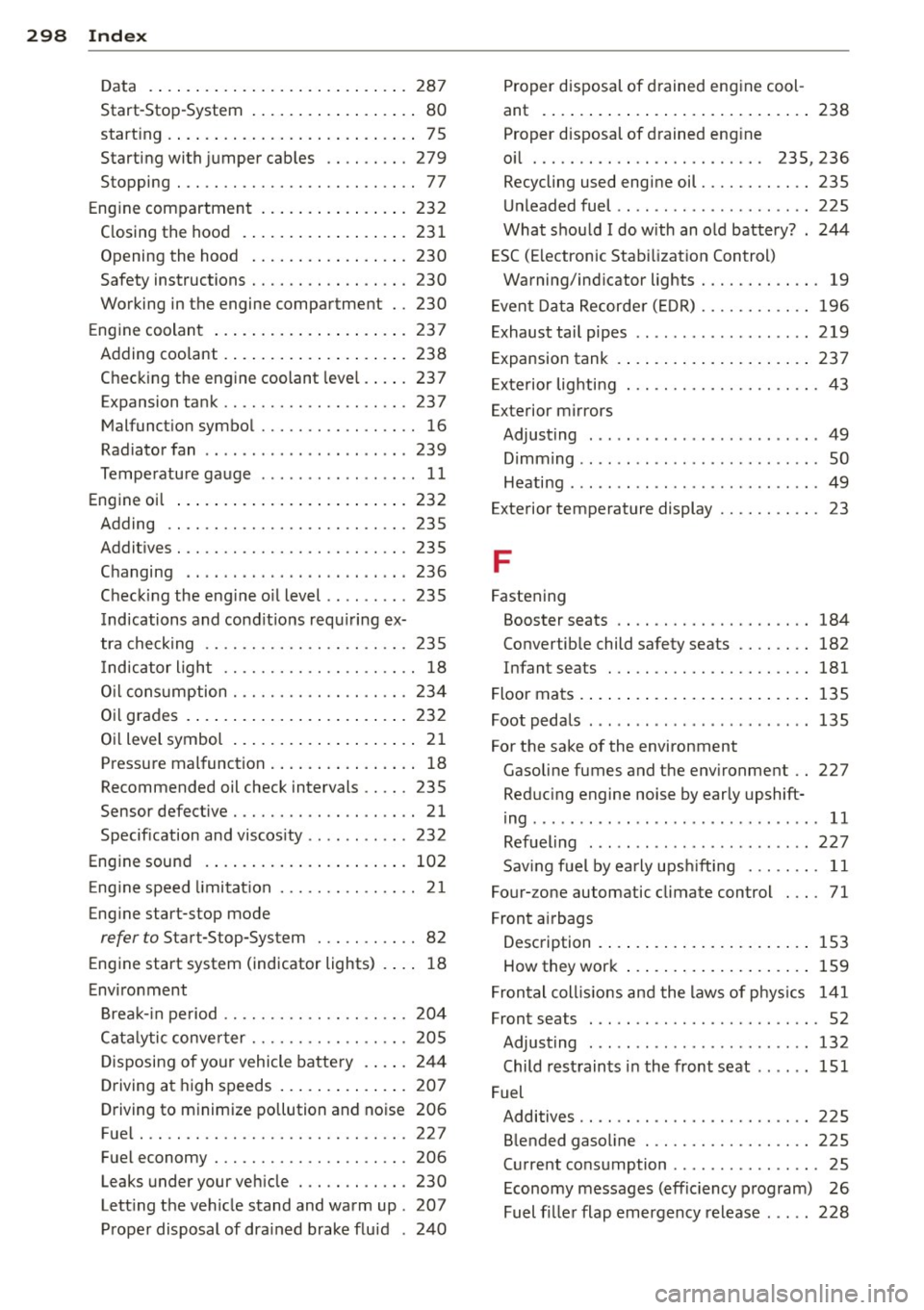
298 Index
------------------------------------
Data .... ....... ......... ... .... . 28 7
Start-Stop-System . . . . . . . . . . . . . . . . . . 80
start ing .. .. ................ ..... .. 75
Starting with jumper cables .. .. ..... 279
Stopping . . . . . . . . . . . . . . . . . . . . . . . . . . 77
Engine compartment ........ .... ... . 232
C losing the hood . . . . . . . . . . . . . . . . . . 231
Opening the hood ................. 230
Safety instructions ........ .. .. .... . 230
Working in the engine compartment .. 230
Engine coolant .................... . 237
Adding coolant ............ ... .... . 238
Checking the engine coolant level . . . . . 23 7
Expansion tank ........... .. .. .. .. . 237
Malfunction symbol ....... .. .. .... .. 16
Radiator fan .............. ... .. .. . 239
Temperature gauge ........ ..... .. .. 11
Engine oil ... ................ ..... . 232
Adding .. .... ........... .... .... . 235
Additives . .. ............. .. .. .. ... 235
Changing .... ... .... .... .. .. .. .. . 236
Check ing the engine oil level .. .. .. .. . 235
I ndications and cond it ions requ iring ex-
tra checking .. ........... .. .. .... . 235
I ndicator light ........... .. .. .. .. .. 18
O il consumption .......... .... .... . 234
Oil grades . ................. ..... . 232
Oil level symbol .................... 21
Pressure malfunction ....... ... .. .. .. 18
Recommended oil check intervals ..... 235
Sensor defective . . . . . . . . . . . . . . . . . . . . 21
Specification and viscosity .. .. .. .. .. . 232
Engine sound .............. ... .... . 102
E ng ine speed limitation ....... .. .. .. . . 21
Engine start-stop mode
refer to Star t-Stop-System ... .. .. .. .. 82
Engine start system (indicator lights) . ... 18
Environment Break-in period ......... .. .. .. .. .. . 204
Cata lytic converter ........ .. .. .. .. . 205
Disposing of your vehicle battery . ... . 244
Driving at high speeds .............. 207
Driving to minimize pollution and noise 206
Fuel . .. .. ............... .. .. .... . 227
Fuel economy ............ .... .... . 206
Leaks under your vehicle ... .. .. .. .. . 230
Lett ing the vehicle stand and warm up . 207
Proper disposal of drained brake fluid . 240 Proper disposal of d
rained engine cool-
ant ..... ..... .. .. .............. . 238
Proper disposal of drained eng ine
oil . . . . . . . . . . . . . . . . . . . . . . . . . 235, 236
Recycling used engine oil ........ .... 23S
Unleaded fuel .. .. ................ . 22S
What should I do with an old battery? . 244
ESC (Electronic Stabilization Control) Warning/indicator lights ........ .. .. . 19
Event Data Recorder (EDR) ........ .. .. 196
Exhaust tail pipes .. .......... ...... . 219
Expansion tank .... ................ . 237
Exterior lighting . ... ............ .. .. . 43
Exterior mirrors Adjusting ..... .. .. ........ ...... .. 49
Dimming . . . . . . . . . . . . . . . . . . . . . . . . . . 50
Heating ...... ... .. .............. .. 49
Exterior temperature display ...... .. .. . 23
F
Fastening
Booster seats .. .. ............. .... 184
Convertible child safety seats . . . . . . . . 182
Infant seats ... .. ............. .... 181
Floor mats . ..... .. ................ . 13S
Foot pedals ..... .. ..... ........... . 13S
For the sake of the environment Gasoline fumes and the environment .. 227
Reducing engine noise by early upshift-
ing ...... .... ... .. ................ 11
Refueling ... .. .. ....... ...... .. .. 227
Sav ing fuel by early upsh ifting . .. .. .. . 11
Four- zone automatic climate control . .. . 71
Front airbags
Description .... .. ................ . 1S3
How they work ... ................ . 159
Frontal coll is ions and the laws of phys ics 141
Front seats . . . . . . . . . . . . . . . . . . . . . . . . . 52
Adjusting ... .. .. ....... ...... .. .. 132
Child restraints in the front seat ...... 151
Fuel Additives .. .... .. ............. .... 225
Blended gasoline .............. .... 225
Current consumption .............. .. 25
Economy messages (efficiency program) 26
Fuel filler flap emergency release ... .. 228